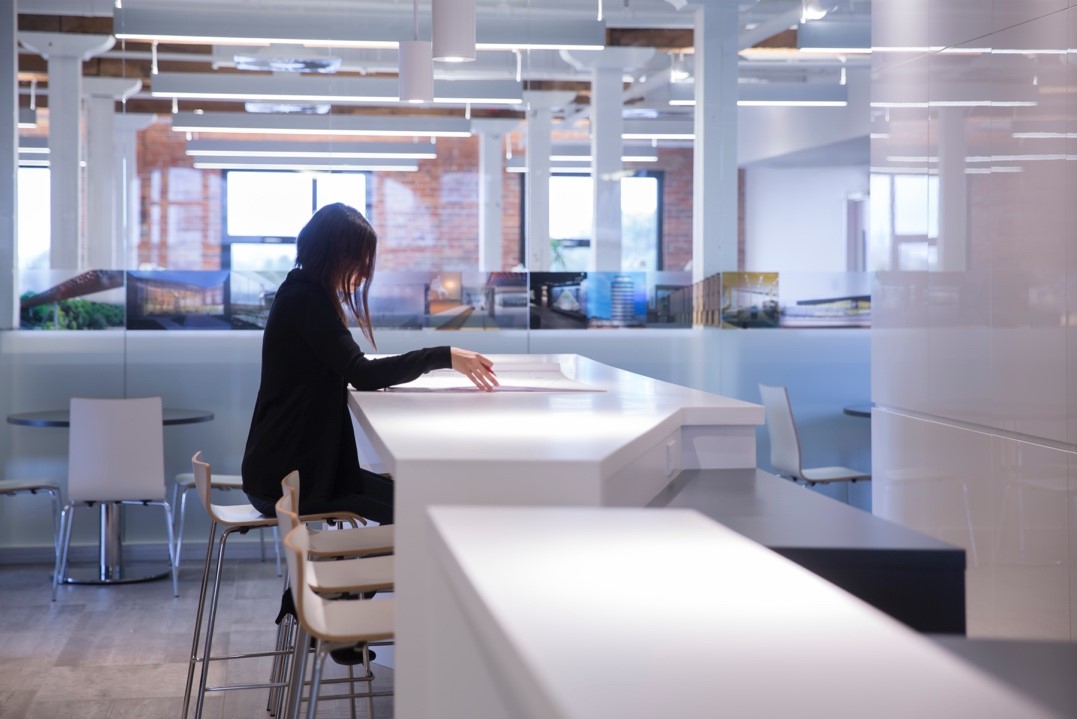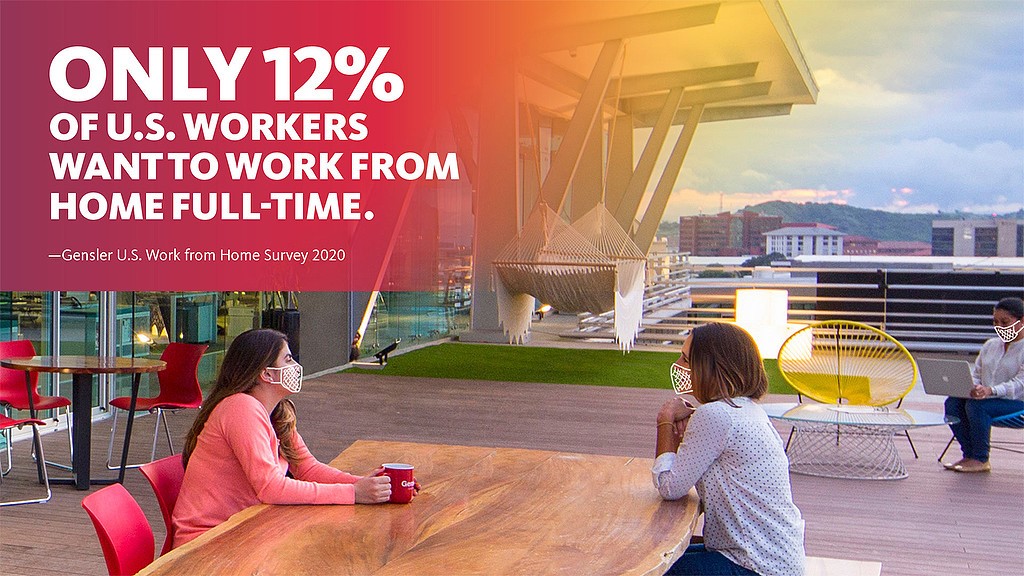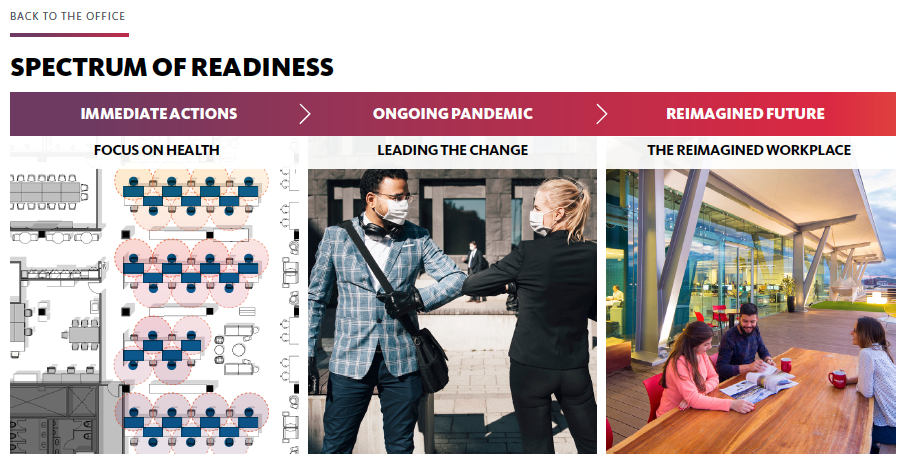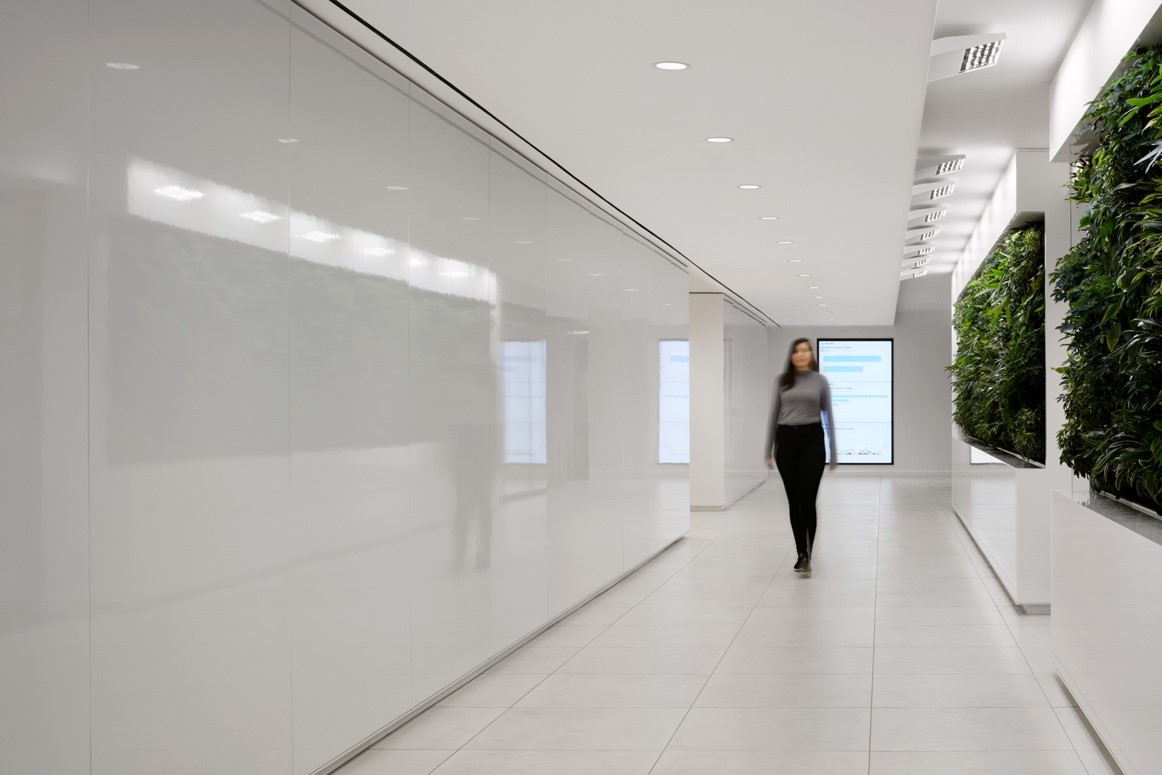
Inside Lemay’s Quebec office. Post-COVID, many firms anticipate a greater number of staff will continue to work at home, freeing up office space. Photo by Stephane Groleau
No one could have predicted a global pandemic would be the catalyst to jumpstart the remote work movement. There is, however, still a long way to go.
Since COVID-19 turned the world sideways and forced everyone indoors, the Gensler Research Institute has been feverishly publishing articles and conducting surveys on how the pandemic is affecting the architecture and design industry. Among the more interesting findings, gleaned from over 2,300 survey responses, is the revelation that only 12 percent of the workforce prefers working from home full-time. In other words, the dream of sitting at the cottage dock with a laptop and far from the hassles of urban life is a bit of a myth. As interactive creatures who depend on cooperation and appreciation from others, we humans are reluctant to be separated from our colleagues. We need, want and desire their contact, just not all the time.

Gensler’s Work from Home Survey revealed that the overwhelming majority of people want to return to the office post-pandemic. Image courtesy of Gensler
Since February, most offices have made the essential adjustments to accommodate remote working by shifting to cloud-based technology and scheduling regular morning meetings via Zoom to keep teams connected and informed. Louis T. Lemay, co-founder of the architecture firm Lemay, which has six offices across Canada and a staff of over 500, says the transition was fast and furious. “We already had software for this sort of thing, but we only used it 10% of the time. Now, it’s closer to 60%.”
His firm was able to move to home set-ups within a week. Employees borrowed office furniture, and the company covered any costs associated with missing tools required to work from home. Productivity did slow down, naturally, but the move to remote working also revealed insights Lemay now plans to build on in the future. For one, he noticed fewer people show up late for meetings. Now that travel to and from the office is no longer an obstacle, teams can easily go from one meeting to another in less than a minute. People seem to be far more interested in sharing and talking, too, more so than when they were in an office setting.
Lemay also discovered that flexible hours aren’t as disruptive as presumed. People are generally more productive without distractions and may work better at night, for instance, when the kids have gone to sleep. “Before COVID, we managed projects by clocking hours,” he says. “Now, it’s about delivering, which is a much better way to manage.”
Siri: Unlock my office
During these unprecedented times, the internet has proven to be superb at hatching creative options to enhance productivity and time management, while virtual meeting apps have become the biggest winners. There are also copious amounts of data being generated to help breakdown how the pandemic will remap office environments post-lockdown. ThinkLab, a research-based marketing firm in New York, is offering the A+D community online courses on developing a new cultural mindset in preparation for the “unpause.” Similarly, Gensler has titled one of its many helpful infographics as The Spectrum of Readiness, where the primary focus should be on workplace health and hygiene, spacing out workstations, and writing guidelines for how returning employees can safely circulate within the office.

Back to the Office guidelines published by Gensler offer a comprehensive roadmap on prioritizing needs in the near and long term. Image courtesy of Gensler
Crowd behaviour in the office
Toronto studio Lebel + Bouliane reopened in early June, providing ten returning employees with a list of protocols, including instructing half of the staff to use the back entrance; the other half to enter and leave through the front door. While the physical space has been temporarily addressed, co-principals Natasha Lebel and Luc Bouliane manage operations and anxieties from afar. “We are spending most of our time supervising staff and emotions,” says Lebel, “and coming up with a vision for what will happen next.” Like many firms, she can’t predict where they will be in September.
Gensler’s Spectrum of Readiness goes on to outline a long-term vision when offices adopt as many germ-free aids as possible, including well-marked wayfinding, voice- or motion-activated light switches, locks and thermostats and screens around desks. Experts are also predicting the rapid return of cubicles.

Along with touch-free automation offices will be prioritizing germ-resistant surfaces and cleaner air systems including living walls. Photo by A Frame
Interior landscapes
When the metamorphosis of transforming workspaces does takes place, it will likely be easier for tech companies to adapt. Lebel & Bouliane has worked on many interiors for creative studios and start-ups where enclosed environments have long since given way to multiple break-out areas. Extended sofas for casual meet-ups or the steps of in-house amphitheatres lend themselves more naturally to social distancing and mobile desking. For an ad agency in Tribeca, the firm created flexible, collaborative spaces specifically designed to be multi-functional. “We often try to make our interiors as landscapes, which can easily adapt to changing behaviours,” says Lebel.

Lebel & Bouliane’s renovation of Algoma University in Brampton, offers students spacious areas for social distancing. In the long run, interiors with room for casual meet-ups will fare better than traditional offices.
The effects of COVID have been massive as well as microscopic. It’s been a Twilight Zone of multiple realizations. Lemay is convinced that flexible work hours are here to stay and collaborating with talents anywhere will also be more fluid now that virtual work is a global phenomenon. Like Gensler and Perkins + Will, most research-based firms predict most of us will be experiencing a third and two-third split between working at home and meeting face-to-face at the office.

Experts predict the workplace will shift from a place to work to a place to convene. The offices of Cannabis tech start-up Lift, designed by Lebel & Bouilane, are already filled with colourful social and collaboration spaces.
Another revelation Lemay and others anticipate is the need for less square footage. With fewer people gathering at any given time, offices are destined to become smaller hubs, geared to enhance work culture and connections. Desks will be spaced further apart but there will be fewer of them. It is still too early to predict how or if shrinking offices will affect real estate. According to Lemay: “We won’t see a dip for another two years when leases start to end.” The remote-work movement has simultaneously raised the possibility that residential design will undergo significant changes, offering new interior configurations for the at-home worker.

With more people spending time at home, residential spaces are likely to transform. Office Ou of Toronto recently turned a laneway garage into a multi-functional space, ideal for dining, entertaining or working. Photo by Adrian Ozimek
Written by Catherine Osborne